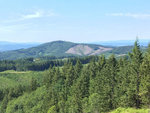

By Washington Forest Protection Association
Trees may be the superheroes we need to fight climate change.
Sustainably managed forests, such as those in the Pacific Northwest, play a vital role in curbing climate change in two ways: by removing carbon from the atmosphere and storing it for the life of the wood product, and also by providing a natural, renewable and less energy-intensive building material.
Daily activities such as driving our cars, using our home appliances and burning fossil fuels release carbon dioxide into the air. Most scientists agree that climate change occurs when an excess of certain greenhouse gases accumulate in our atmosphere through natural and human-induced activities, trapping heat and radiation. Carbon dioxide is one of those compounds.
Trees, however, may be one of the most important tools we have to combat climate change. Superheroes, if you will.
Trees absorb carbon dioxide from the air like a sponge in a process called photosynthesis. In photosynthesis, a tree uses sunlight to convert carbon dioxide into oxygen and sugars — glucose and starch, which are made up of carbon-based molecules. (You may remember some of this from science class.) The oxygen is released back into the atmosphere and the sugars feed the tree and help it grow. Trees hold onto carbon for a long time in their wood, a process called carbon sequestration.
If trees are climate change superheroes, then carbon sequestration is their superpower.
Trees continue to hold onto carbon even after they are sustainably harvested and made into useful things, such as furniture, houses, boats and paper products. The dry weight of wood is about 50 percent carbon. A wood product holds onto the carbon as long as it is still a wood product.. When we use wood, and replant a tree, we start the carbon storage cycle all over again. And, after a lifetime of iterative recycling, wood material can be used for bioenergy production, further supplanting the role that fossil fuels play in our lives.
Forests are among the most effective carbon sinks, which are active mechanisms that absorb carbon dioxide, thriving most in that role during younger periods of tree growth. Moreover, wood products are among the most effective carbon stores — objects that naturally hold onto carbon within their structures.
Washington’s forests and wood products store 35% of our state’s carbon emissions, and it is increasing. On timberland in Washington, not including forests setaside for parks, wilderness and recreation, carbon stocks and trees are growing at nearly twice the rate of harvests on average. (FIA, 2016).
And a recent study done by the University of Washington shows almost 13 percent of Washington’s carbon emissions are offset by private working forests and wood products.
In order to keep these forests efficient in reducing carbon dioxide in the atmosphere and curbing the natural and human-made greenhouse effects, forest land needs to be working and sustainable forestry practiced. In Washington state, strong forestry laws and third-party certification standards ensure that wood building materials are produced in an eco-friendly, sustainable way.
Thus, choosing wood products for building can be an effective strategy in decreasing greenhouse gas emissions. Wood is renewable and requires significantly less water, energy and fossil fuels to manufacture than steel, plastic or concrete. In fact, when we substitute wood for energy-intensive building products, we offset two tons of carbon emissions for every dry metric ton of wood used, on average.
In order to avoid losing our forests, we need to use wood products build homes and buildings. Around the globe where there is industrial round wood harvest, the countries that the highest industrial round wood harvest actually have the more stable or increasing carbon stocks. So what this means is that demand for wood products actually are helping keep forests on the landscape by having an economic value for that land.
Responsibly managed forests already provide drinking water, contribute to a healthy climate, preserve wildlife habitat and create green jobs in rural economies. Through sustainable growth practices and carbon sequestration, responsibly managed working forests can also help improve our world for future generations.
The Washington Forest Protection Association is a trade association representing private forest landowners in Washington state. Members are large and small companies, individuals and families who grow, harvest and re-grow trees on about 4 million acres.